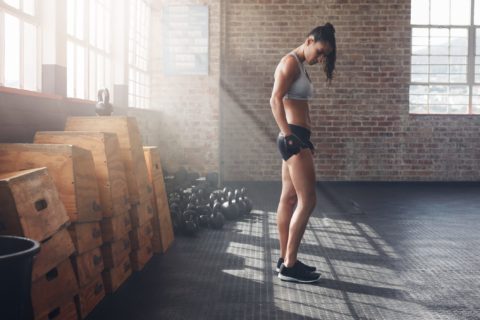4 Ways to Measure Your Fitness Gains Without the Scale
I’ll never forget the day I learned that the scale is not always a reliable measure for health and fitness. During my personal-training certification course a few years ago, we were asked to practise calculating each other’s Body Mass Index (BMI). My partner in this exercise—a super-strong, badass cop—and I swapped heights and weights to calculate each other’s BMI (your weight in kilograms, divided by height in metres squared), and I distinctly remember having some trouble with her result. Every time I entered the numbers, I got a score that classified her as being extremely overweight. This was confusing because she was literally one pair of abs shy of having a complete six-pack. Of all the words I would use to describe her (strong, capable, toned, muscular), “overweight” was not on the list. Similarly, she was having trouble calculating my BMI value. So there we were, two women deemed “nearly obese” by this measure, when our lives and livelihoods were devoted to being fit and healthy.
So, why was this measure, which many health practitioners still use to classify body weight and calculate risk for heart disease and diabetes, so off the mark for us? Toronto-based personal trainer and nutritionist Jessica Morris explains, “It is a very broad assessment of a person’s body fat, solely based on their height to weight ratio. But it does not tell us a person’s lean muscle mass in comparison to their body-fat percentage.” This means that for those who are quite muscular, the values can be a little misleading. In fact, both Morris and I agree that stepping on the scale, in general, isn’t always a reliable or reflective measure of one’s health status. How our bodies look and feel, and what they can do, should be considered to get the full picture. So, instead of being a slave to the scale, here are some alternative ways to assess your health and fitness progress.
Body Composition
A common complaint I get when clients start a new fitness program is, “Why is the scale going up instead of down?” Morris breaks down the science behind these frustrating realities: “Muscle takes up less space and is more dense than fat, so even if your measurements are going down, the number on the scale may remain the same. I always tell my clients to focus less on the number on the scale and more on how they look in the mirror and how their clothing fits. This will give them a better idea of their fat to muscle ratio.” For those who like numbers, the average woman has between 21 and 25 per cent body fat, and anything up to about 32 per cent is still considered quite healthy. Many gyms have special body composition scales these days, but if that isn’t accessible, most trainers and physicians know how to use fat calipers. All it takes is a small pinch in a few areas of the bod for a pretty accurate idea of your fat-to-muscle status. Again, don’t stress about the number—the goal is improvement, not comparison.
Strength Tests
When it comes to fitness, strength and endurance are incredibly helpful markers of our progress. The “push-up test” is a great way to analyze our baseline strength and subsequent muscular progress—and, according to Morris, unlike some of the other measures, it’s super easy to do on your own. “Strength testing is a fantastic tool to measure progress because the results are immediate and simple to assess,” she says. Before you drop and gimme 20, here’s how it works: From the knees, perform as many push-ups as you can in 60 seconds without breaking form. (That means without arching the lower back, popping up the butt into “table top” or letting the elbows splay out.) It doesn’t matter how many you can do as long as the number is going up and not down over time. “If you start a program and can do five push-ups, then a few weeks later are able to do 10, then clearly you can tell that you are gaining strength,” she says. “If the opposite happens or your number plateaus, I recommend that you re-evaluate your fitness program.”
Blood Pressure
One of the biggest reasons to get in shape is to improve your quality of life and longevity. (Although sometimes it seems like these goals get lost in the shuffle of getting thin…Le sigh.) A huge component of overall wellness is how our heart functions, and getting fit directly affects its efficiency. Morris explains: “When you train, you want your heart to work effectively and efficiently. A lower heart rate while exercising means your body has to work less hard to pump the blood through your body and to your heart.” This means, as we get in better shape, our bodies become more efficient and our blood pressure and resting heart rate will go down. “I recommend everyone get their heart rate and blood pressure measured before starting any fitness and nutrition program,” she says. It’s best to start this in your doctor’s office, but you can also ask your pharmacist, as many pharmacies have blood pressure machines on site.
Measurements
“Measurements are a positive and staple tool that I use in my practice as a way to measure a persons health, strength and achievements,” says Morris. Like body composition analysis, taking measurements can determine if you’re losing fat and gaining muscle. As you improve your fitness, measurements will generally go down (unless you’re working to build size). Remember, there is no “perfect” number. “I usually don’t tell my clients their measurements to begin with,” she says. “It is only after time has passed and the numbers shift that I tell them the difference between where they were when they started and where they are now.” The reason for this, she says, is we tend to obsess over numbers that are truly irrelevant in nature.








